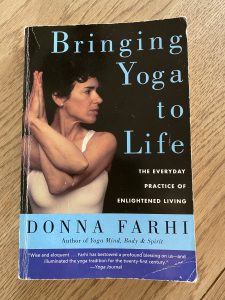Has anyone else noticed that in the last few years, there has been an increase in the number of what I might call ‘sport specific’ yoga classes on offer? Of course, like everything, they’ll be really good ones and not so good ones. I have been asked and also considered offering some myself in the past few years. Does it make sense? Is it just Marketing? A recent book got me to thinking about why I’ve not actually done it. I wanted to share some thoughts without judgement. After all for some, this will be a great way into the art and science that is yoga.

It’s difficult with yoga. To explain it we have to reduce it somehow and yet the very nature of yoga is expansionist.
Many practitioners know that the yoga which is often taught in the West is sometimes called ‘postural yoga’ because it focuses on only one or two of the eight limbs of yoga. As a reminder the eight limbs are:
- yamas (universal morals)
- niyamas (our own individual ways of behaving)
- asanas (the postures we know to be ‘yoga’)
- pranayama (the study or control of the breath)
- pratyahara (‘control’ of the senses)
- dharana (concentration/focus)
- dyhana (meditation)
- samadhi (enlightenment)
To teach a class specifically for something, for a purpose, I wonder if we’re missing the point. Of course we can teach specific asana for the hamstrings, the glutes, the hip flexors and so on. We can teach breathwork to become more efficient in our breathing mechanics. We can use breath, senses and focus to get ‘in the flow’, to reach new achievement goals, and so on. Is this sports science or yoga? Is it scientifically proven to help? Does it matter because it’s all really good stuff? Perhaps.
Those who regularly come to my classes know that ease of movement is important to me. But it’s just one part. After my training and qualification with bio-mechanist Jules Mitchell, I came to realise that ease of movement for me is multi-dimensional. Yes ease of movement physically, but also mentally, emotionally, spiritually. A good yoga class must surely seek to offer all of this. As a teacher, I can say that isn’t easy, but it’s a great challenge.
Whatever yoga class you find is the best one for you (and we all know it’s individual and subjective), it’s worth remembering Aparigraha. Aparigraha is the last Yama in the eight limbs of yoga. It means non attachment. For me this is a fundamental part of the true essence of expansionist yoga. Practising yoga, living life with non-attachment to the outcome. Without purpose or even with the ‘purpose’ of leaving no trace on this beautiful planet… before it’s too late. Non-attachment, the toughest pose/sport/movement of all and yet surely the most important.
If you’re interested in learning more about yoga off the mat, I highly recommend Donna Fahri, Bringing Yoga to Life.
It’s a wonderful and easy read into the richness of yoga. As you can see my copy has been around for 20 years and I often find myself coming back to it. If you choose to read it, I’d love to know your thoughts. Emma x


